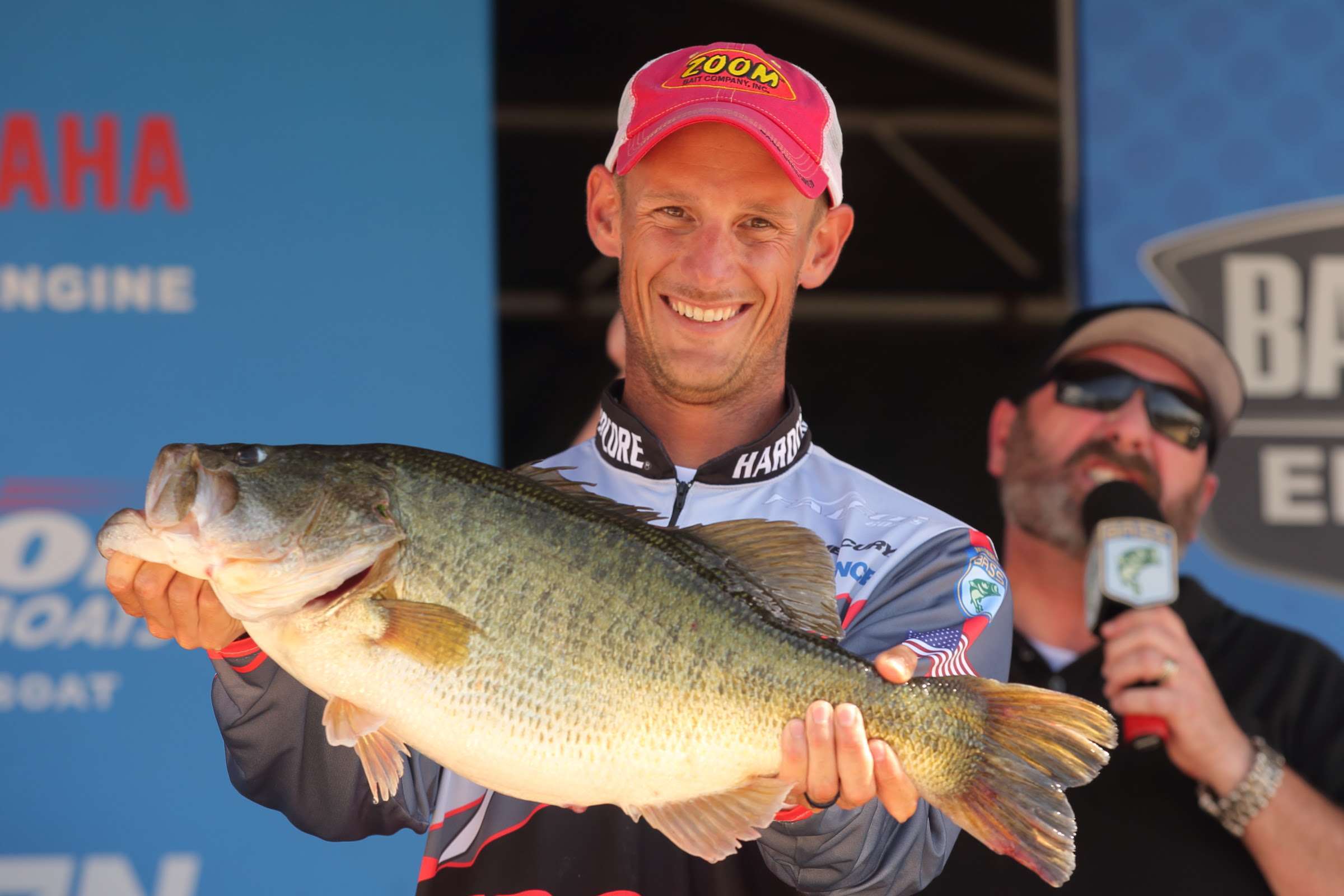
We’re starting the second quarter with a bang, as prespawn/spawning season offers great opportunities to bend a rod on your personal best. Check out what these Elite anglers have to say about tracking down the giants of spring.
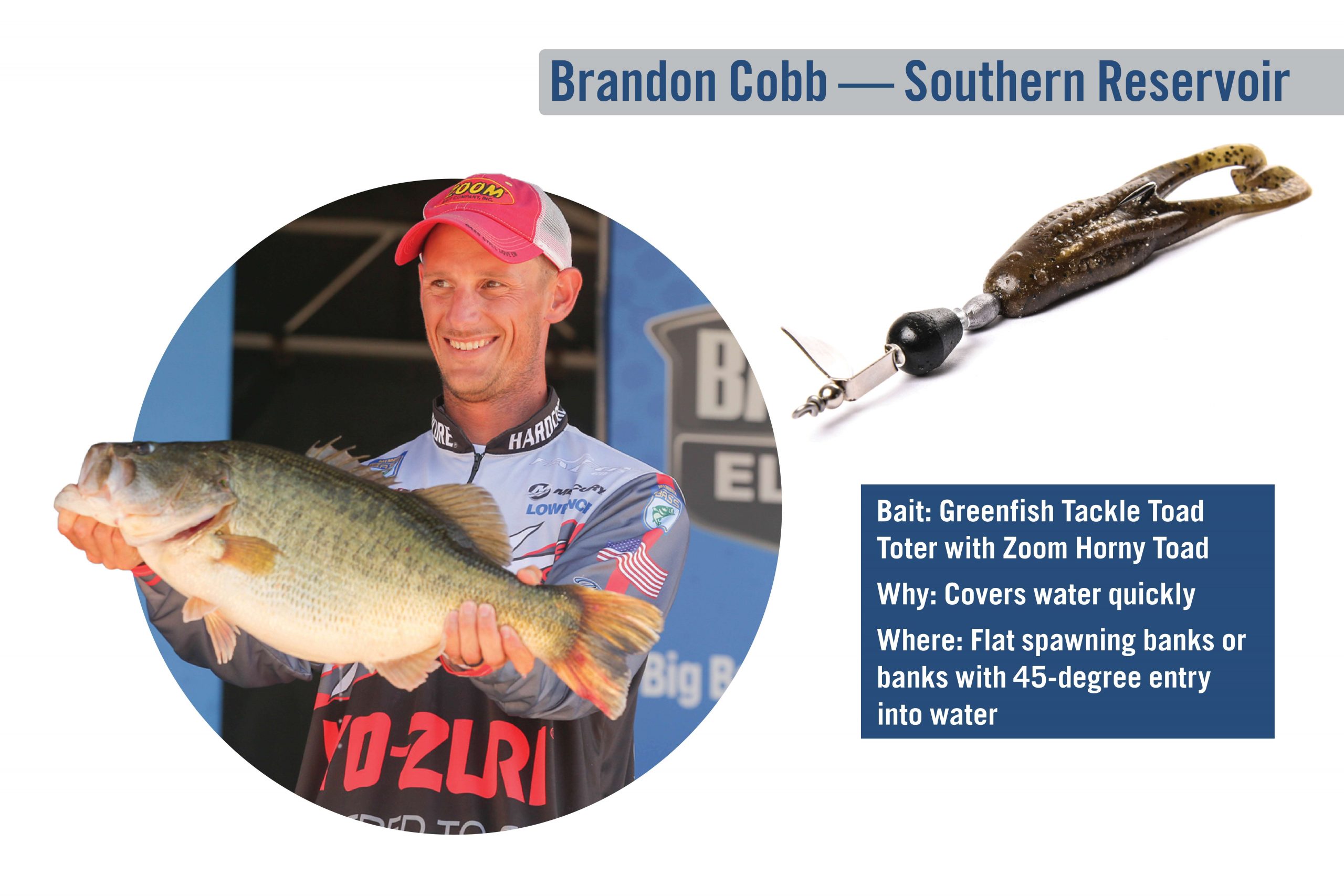
Brandon Cobb
Looking primarily for spawners, with some in postspawn mode, the easygoing Bassmaster Elite Series angler from South Carolina does his best to create the kind of head-turning commotion that redlines a giant largemouth’s aggression. He does so by focusing on shallow spawning zones and covering water with a buzzbait.
On lakes such as Murray, Hartwell and Lanier, Cobb’s weapon of choice is the Greenfish Tackle Toad Toter, which features a streamlined, skirt-less form with an unpainted leadhead designed with bait keepers. He pairs this with a Zoom Horny Toad, which enhances the disturbance and provides the lift he needs to keep the bait running high in the water column, even at slow speeds.
“This time of year, a lot of it is sight fishing for cruising fish, but I’m going to cover water with a buzzbait and throw way out ahead of me to try and catch big females that are up before I get there,” Cobb said. “I usually lead with a white Horny Toad, but sometimes, I’ll use black if they’re missing.”
Of his presentation specifics, Cobb said, “In most Southern reservoirs, you have the typical flatter spawning banks and 45-degree banks. When I’m throwing the buzzbait, I keep my boat close enough that I can look for spawning fish or cruising fish, while allowing myself enough room to throw ahead of the boat and keep the bait near the bank the whole time.
“I’m not quite paralleling the bank, but I’m not at a 45-degree angle. I’m probably at about 30 degrees. It’s not a high-percentage bait, but a real giant will eat that buzzbait.”
Cobb, who designed the Toad Toter, said the bait’s built to stay high in the water column, even at slow speeds. Good thing, because he finds the best presentation is just fast enough to keep the blades turning — a pace facilitated by the toad’s added lift.
“The only time this doesn’t work is when you have a lot of grass,” Cobb said. “In that scenario, I’d just go with the Horny Toad. You still want something that stays high and makes a lot of commotion, but the buzzbait’s too difficult to work in the grass.”
Obviously, the buzzbait won’t make the starting lineup for bed-fish baits, so Cobb keeps a Texas-rigged Zoom Z Craw on standby. If he spots a bedding bass, or if one swirls at the passing reaction bait, he’ll pause and flip to the target.
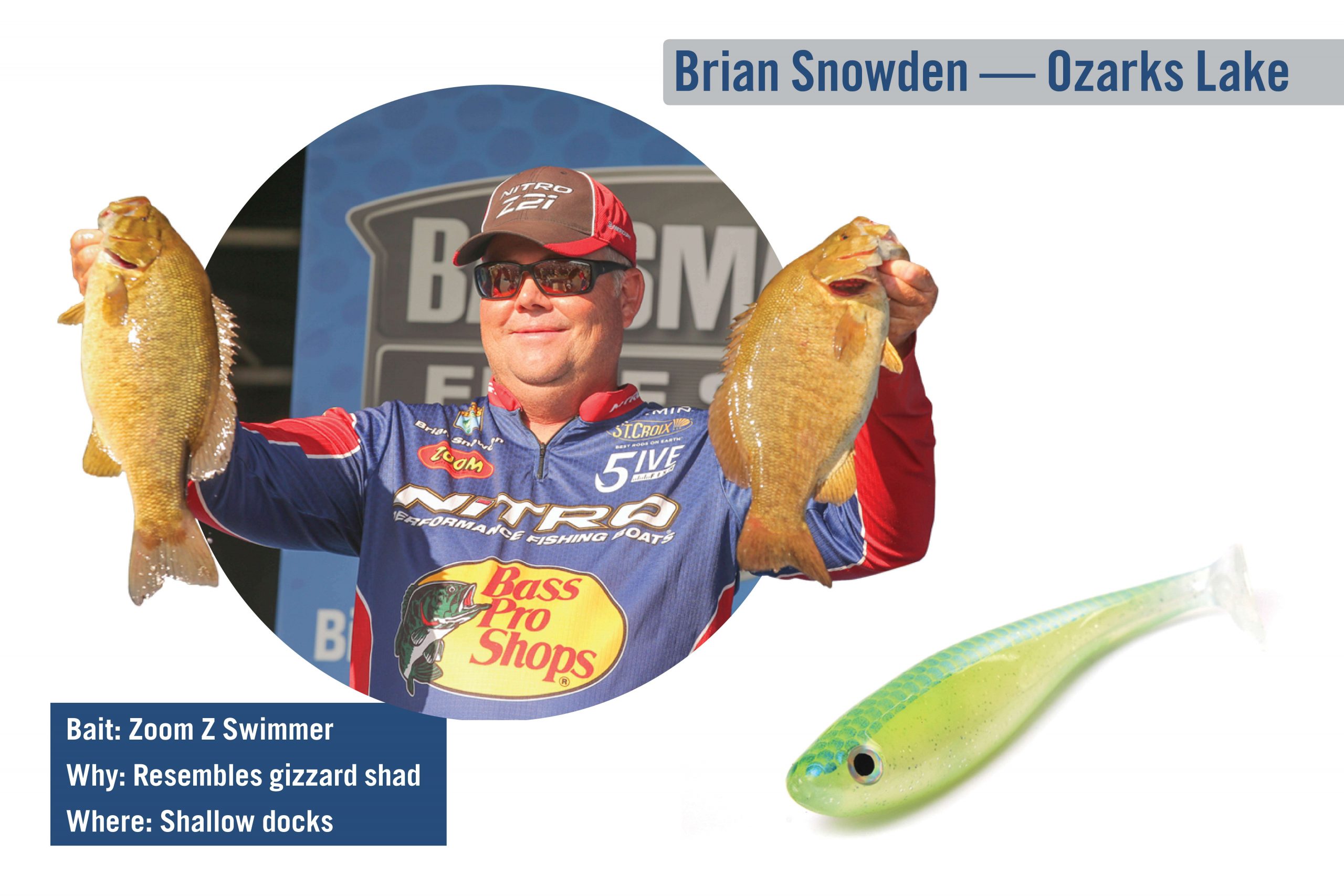
Brian Snowden
Depending on weather patterns, Snowden wouldn’t rule out a few bed fish, but he’s mostly expecting prespawners; in which case, he wants to show these hungry tanks a substantial meal that resembles a gizzard shad. Snowden’s main choice is a 5-inch Zoom Z-Swimmer in one of two rigging options, depending on the water level.
“If the water is high and I have flooded buckbrush and willow trees, I’m going to rig it weedless Texas style with a 6/0 Owner weighted hook with a 1/4- to 3/8-ounce weight on the shank,” he said. “If the water has a little color, I’m going to use a hook with the Owner Flashy Spin [swiveling blade]. I’ll throw it almost like a spinnerbait, but it’s just a bigger profile.
“I’m going to fish the Texas-rigged bait on secondary and main-lake points around the flooded brush. I’d work it a foot or two into the flooded brush and around the outside edge.”
When low-water scenarios take the bushes out of play, Snowden switches to an open-hook rigging style. Here, he’ll use a 3/8- to 1/2-ounce leadhead jig, based on his desired depth range.
“I’m going to concentrate on docks close to a spawning cove, like those on the side of a secondary point or leading into a spawning area,” Snowden said. “They’ll suspend a lot around those docks, as well as in flooded cedar trees.”
Backing up the hollow-body swimbait, Snowden occasionally diversifies the gizzard shad ruse with a 6-inch Bass Pro Shops XPS glide bait. It’s particularly relevant as water temperatures rise into that 58- to 62-degree range that tells him the spawn is near.
“When the fish are moving around, the bigger glide bait works exceptionally well in our clear-water lakes,” Snowden said. “It’s amazing how many followers you’ll get on the glide bait, but when you get one to commit, it’s a better one.”
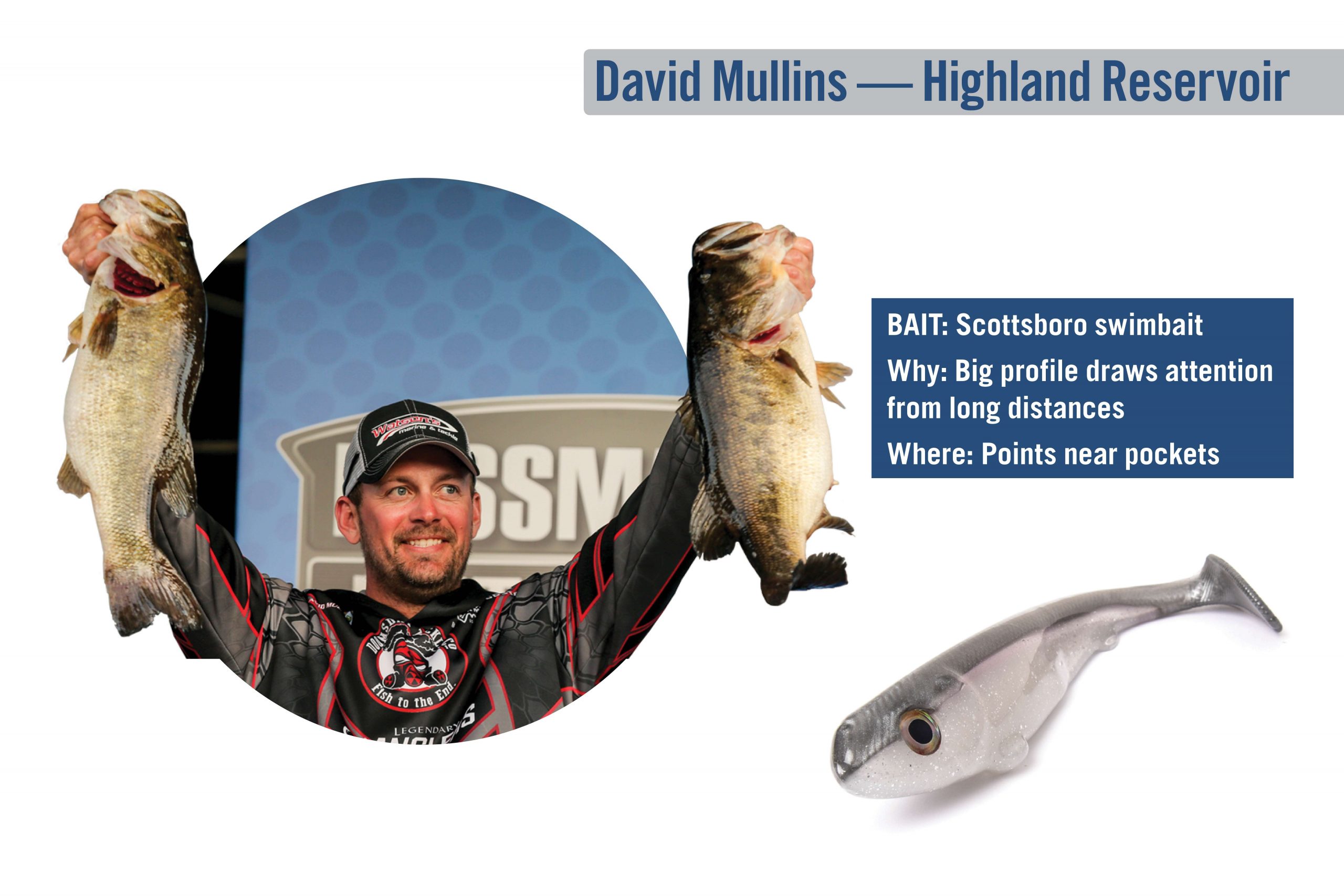
David Mullins
With water temperatures in the high 50s to low 60s, Mullins knows his best shot at catching a giant is tempting one of the big mamas that’ll rise from deep water to feed on particular prespawn staging areas. Targeting main-lake or secondary points near the mouths of spawning pockets, he’ll dial in the sweet spots based on access and feeding opportunities.
“The best ones seem to have isolated cover, like pea gravel or stumps,” Mullins said. “Also, there’s a steep drop where those big fish can move up and down fast. It doesn’t have to be at the end; it can be on the side.”
Going right to the playmaker, Mullins attacks these points with a 7-inch Scottsboro swimbait in ole smoky or his custom color, Mullins Madness. Given the lack of aquatic vegetation in this scenario, he’ll rig the bait on a custom-made 1/2- to 3/4-ounce screw-lock jighead built on an 8/0 hook.
“That bigger profile draws more attention; they can see it from a distance in the clear water,” Mullins said. “There’s not a lot of finesse with it; you just throw it out and wind it back pretty slowly.
“The action is in the tail of the swimbait. You’ll find a sweet spot where they swim the best, and once you find it, that’s how you [retrieve it]. You can reel them too fast and you can reel them too slow. For the most part, you’re reeling it fairly slow and trying to draw a fish from a long way.”
With fish often suspending off the points, Mullins said he’ll keep his bait lower in the water column, but off the bottom. With his boat sitting in about 15 feet of water and the fish no deeper than 10, he’ll cast to the bank and start reeling as soon as the bait hits the water to ensure that it follows the bottom contour on a pendulum swing.
“On a steeper bank, I’ll reel it slower to keep it down, but if the point you’re fishing is shallow, you might have to reel faster to keep it up,” Mullins said.
Daily conditions matter much, and Mullins finds a light southwest wind later in the day can make magic happen. Give the sun time to warm the water on those points and then break up visibility with surface chop — home run time.
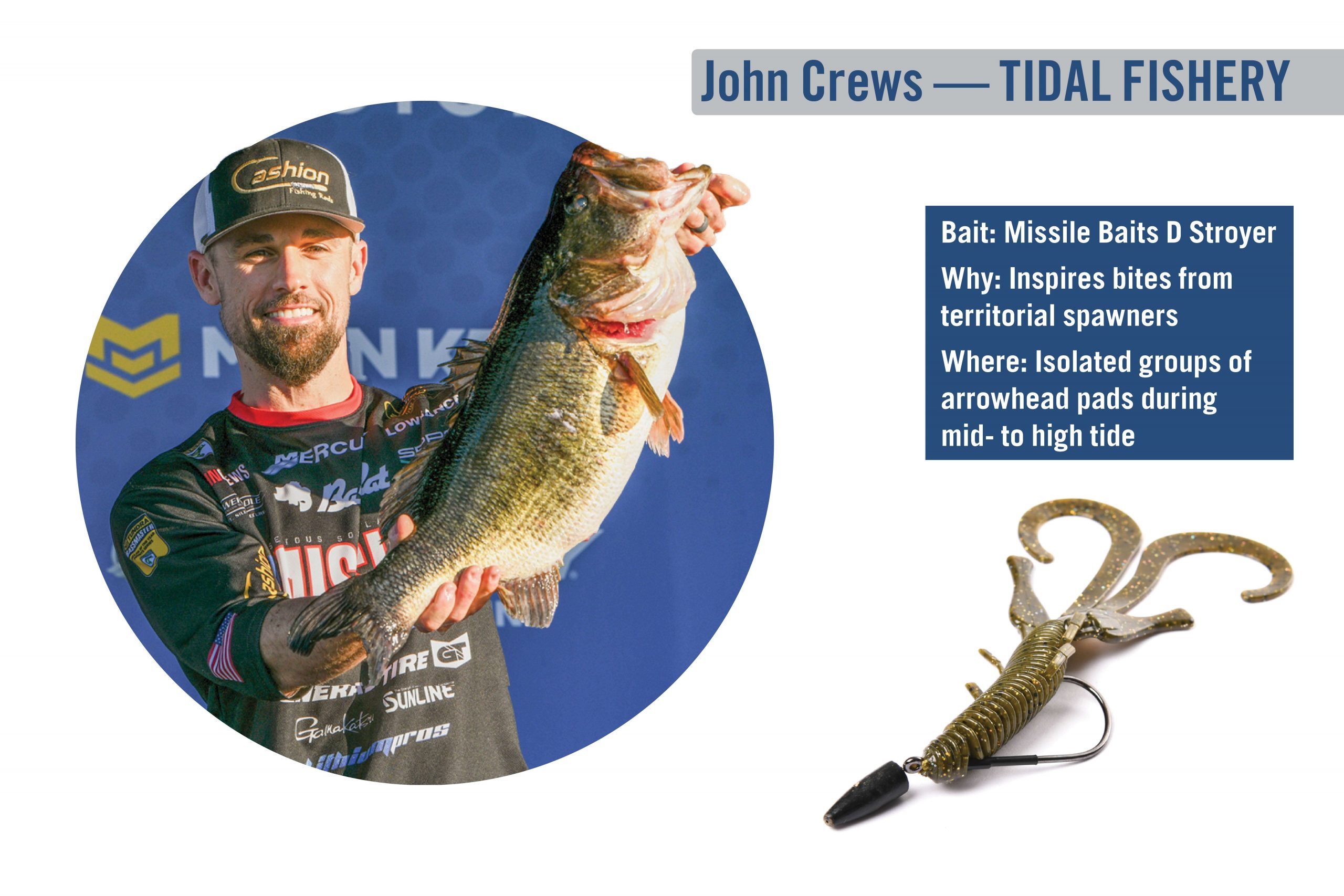
John Crews
Notwithstanding his respect for match-the-hatch wisdom, Crews kicks that thought to the curb when he’s looking for giants in waters controlled by ebb and flow. With large forage fish like gizzard shad and bluegill much less common than scads of minnows and threadfin shad, the Elite angler from Virginia pins his hopes on showing the big ’uns something designed to agitate their seasonal mood.
“That time of year, right before or during the spawn, those big fish get territorial, so they’re more susceptible to oversized creature baits,” Crews said. “A lot of people typically will pitch and flip small to medium-size Texas-rigged baits, and you will have a lot of success throughout the year doing that. But I think flipping a bigger creature bait on a tidal fishery is going to result in a bigger bite.
“In lakes with the larger forage, the fish are used to seeing those larger profiles, but on tidal fisheries, there’s a plethora of small baitfish that use those marshes, and that’s what the fish become accustomed to. I think the larger profile and all the undulation and movement [of the appendages] really triggers that defensive mechanism in them.”
Crews flips a 7-inch Missile Baits D Stroyer Texas-rigged on a 5/0 Gamakatsu Straight Shank Heavy Cover Worm Hook with a 3/8-ounce bullet weight. Braided line is a must for the vegetation so prevalent on tidal waters.
Daily tidal fluctuations will push and pull fish into and out of ideal engagement zones, so even if he has to “chase the tide,” moving up or down the tidal plain to stay with the optimal level, Crews knows his efforts will best match the opportunity of particular scenarios.
“On higher water, look for isolated groups of arrowhead pads; that is far and away the biggest key,” he said. “That time of year, the low tide is not your friend. You want to find mid- to high tide because the fish tend to get really spooky on the lower water.”
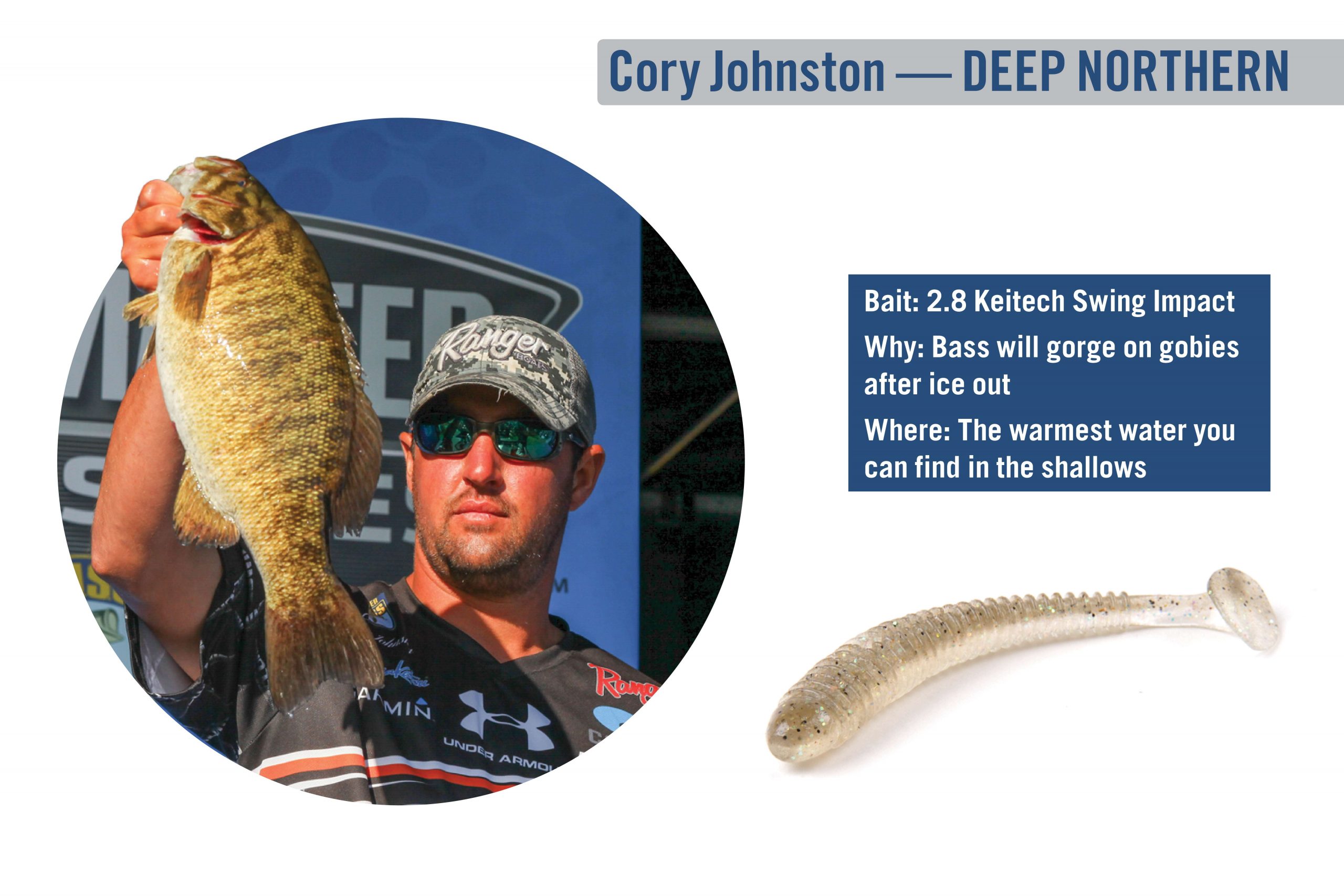
Cory Johnston
Ice-out can vary based on winter’s severity and short-range weather patterns, but early to mid-April typically finds waters opening enough for Johnston to target northern smallmouth. The fish, he said, are remarkably aggressive, but quality combining with quantity often requires a weeding-out effort.
“From my experience, as soon as the ice comes out, the fish are pushing up extremely shallow and they’re trying to find the warmest water possible to go in and feed,” Johnston said. “They’ve had a long winter, so the most important thing that time of year is fishing the warmest water you can find.
“That changes every day, depending on which way the wind’s blowing, but it’s usually back bays, points, shallow rock flats and that kind of stuff where you can find big groups of fish. When you find those big groups, the biggest fish in the lake are in them. It’s very rare that you catch one here, one there.”
Johnston said there’s no surgical way to dial in the jumbo smallies. Frustrating as it may be, grinding through quantity usually rewards him with shots at legit quality — like something in the 6- to 8-pound range.
Using Lake Michigan’s Sturgeon Bay as an example, Johnston said he’ll target rocks and mud flats, while using his Power-Poles to methodically work his way through attractive areas. The fish will be gorging on gobies and the tender crawfish that have recently emerged.
To locate groups of fish, Johnston throws a 2.8 Keitech Swing Impact on a 1/8- to 3/8-ounce homemade ball-head jig built with a 1/0 Gamakatsu 604 jig hook. For targeted presentations, he uses a 3-inch green pumpkin tube on a 1/8- to 3/8-ounce Gamakatsu tube jighead.
“When I thread the Keitech onto the hook, I make sure it’s as straight as possible; that’s a big key,” Johnston said. “It’s as slow as you can reel it — just ticking the bottom. You don’t want to be dragging it because that time of year, a lot of areas have moss. You just want to hit rock every once in a while. They seem to eat it better when you’re just ticking the bottom.”
“With the tube, you’d be looking for little boulders, isolated sand or grass patches or troughs that homeowners dig out [of] an area to access their boat lift. The size of fish will vary, but you just weed through them and hope for the best.”
Originally published by Bassmaster Magazine April 2020.





